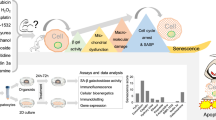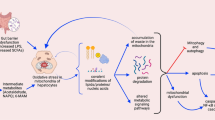Abstract
Hepatitis C virus (HCV) induces the expression of the genes of proinflammatory cytokines, the excessive production of which may cause cell death, and contribute to development of liver fibrosis and hepatocarcinoma. The relationship between cytokine production and metabolic disorders in HCV-infected cells remains obscure. The levels of biogenic polyamines, spermine, spermidine, and their precursor putrescine, may be a potential regulator of these processes. The purpose of the present work was to study the effects of the compounds which modulate biogenic polyamines metabolism on cytokine production and HCV proteins expression. Human hepatocarcinoma Huh7.5 cells have been transfected with the plasmids that encode HCV proteins and further incubated with the following low-molecular compounds that affect different stages of polyamine metabolism: (1) difluoromethylornithine (DFMO), the inhibitor of ornithine decarboxylase, the enzyme that catalyzes the biosynthesis of polyamines; (2) N,N'-bis(2,3-butane dienyl)-1,4-diaminobutane (MDL72.527), the inhibitor of proteins involved in polyamine degradation; and (3) synthetic polyamine analog N1,N11-diethylnorspermine (DENSpm), an inducer of polyamine degradation enzyme. The intracellular accumulation and secretion of cytokines (IL-6, IL-1β, TNF-α, and TGF-β) was assessed by immunocytochemistry and in the immunoenzyme assay, while the cytokine gene expression was studied using reverse transcription and PCR. The effects of the compounds under analysis on the expression of HCV proteins were analyzed using the indirect immunofluorescence with anti-HCV monoclonal antibodies. It has been demonstrated that, in cells transfected with HCV genes, DFMO reduces the production of three out of four tested cytokines, namely, TNF-α and TGF-β in cells that express HCV core, Е1Е2, NS3, NS5A, and NS5B proteins, and IL-1β in the cells that express HCV core, Е1Е2, and NS3 proteins. MDL72527 and DENSpm decreased cytokine production to a lesser extent. Incubation with DFMO led to a 28–32% decrease in the number of cells expressing NS5B or NS5A, both of which are key components of the HCV replication complex. The results obtained in the work indicate that a further detailed study of the antiviral activity of DFMO is required in order to assess its potential as an anti-hepatitis C therapeutic agent.
Similar content being viewed by others
Abbreviations
- APAO:
-
polyamine oxidase
- CHC:
-
chronic hepatitis C
- DENSpm:
-
N1,N11-diethylnorspermine
- DFMO:
-
difluoromethylornithine
- ELISA:
-
immunoenzyme assay
- HCV:
-
hepatitis C virus
- IL:
-
interleukin
- mAb:
-
monoclonal antibody
- MDL:
-
N,N'-bis(2,3-butane dienyl)-1,4-diaminobutane (MDL72.527)
- NS:
-
nonstructural protein
- ODC:
-
ornithine decarboxylase
- OS:
-
oxidative stress
- ROS:
-
reactive oxygen species
- SMO:
-
spermine oxidase
- SSAT:
-
spermidine/spermine N1-acetyltransferase
- TGF:
-
transforming growth factor
- TNF:
-
tumor necrosis factor
References
Li H.C., Lo S.Y. 2015. Hepatitis C virus: Virology, diagnosis and treatment. World J.Hepatol. 7, 1377–1389.
Zampino R., Marrone A., Restivo L., Guerrera B., Sellitto A., Rinaldi L., Romano C., Adinolfi L.E. 2013. Chronic HCV infection and inflammation: Clinical impact on hepatic and extra-hepatic manifestations. World J.Hepatol. 5, 528–540.
Drummer H.E. 2014. Challenges to the development of vaccines to hepatitis C virus that elicit neutralizing antibodies. Front. Microbiol. 5, 329.
Pawlotsky J.M. 2014. New hepatitis C virus (HCV. drugs and the hope for a cure: Concepts in anti-HCV drug development. Semin. Liver Dis. 34, 22–29.
Rupp D., Bartenschlager R. 2014. Targets for antiviral therapy of hepatitis C.Semin. Liver Dis. 34, 9–21.
Attar B.M., Van Thiel D. 2015. A new twist to a chronic HCV infection: Occult hepatitis C.Gastroenterol. Res. Pract. 2015, 579147.
Selimovic D., El-Khattouti A., Ghozlan H., Haikel Y., Abdelkader O., Hassan M. 2012. Hepatitis C virusrelated hepatocellular carcinoma: An insight into molecular mechanisms and therapeutic strategies. World J.Hepatol. 4, 342–355.
Szabo G., Petrasek J. 2015. Inflammasome activation and function in liver disease. Nat. Rev. Gastroenterol. Hepatol. 12, 387–400.
Negash A.A., Ramos H.J., Crochet N., Lau D.T., Doehle B., Papic N., Delker D.A., Jo J., Bertoletti A., Hagedorn C.H., Gale M., Jr. 2013. IL-1β production through the NLRP3 inflammasome by hepatic macrophages links hepatitis C virus infection with liver inflammation and disease. PLoS Pathog. 9, e1003330
Paracha U.Z., Fatima K., Alqahtani M., Chaudhary A., Abuzenadah A., Damanhouri G., Qadri I. 2013. Oxidative stress and hepatitis C virus. Virol. J. 10, 251.
Ivanov A.V., Bartosch B., Smirnova O.A., Isaguliants M.G., Kochetkov S.N. 2013. HCV and oxidative stress in the liver. Viruses. 5, 439–469.
Casero R.A., Pegg A.E. 2009. Polyamine catabolism and disease. Biochem. J. 421, 323–338.
Pegg A.E., Casero R.A. 2011. Current status of the polyamine research field. Methods Mol. Biol. 720, 3–35.
Smirnova O.A., Isaguliants M.G., Hyvonen M.T., Keinanen T.A., Tunitskaya V.L., Vepsalainen J., Alhonen L., Kochetkov S.N., Ivanov A.V. 2012. Chemically induced oxidative stress increases polyamine levels by activating the transcription of ornithine decarboxylase and spermidine/spermine-N1-acetyltransferase in human hepatoma HUH7 cells. Biochimie. 94, 1876–1883.
Battaglia V., DeStefano Shields C., Murray-Stewart T., Casero R.A. 2014. Polyamine catabolism in carcinogenesis: Potential targets for chemotherapy and chemoprevention. Amino Acids. 46, 511–519.
Park M.H., Igarashi K. 2013. Polyamines and their metabolites as diagnostic markers of human diseases. Biomol. Ther. (Seoul). 21, 1–9.
Korovina A.N., Tunitskaya V.L., Khomutov M.A., Simonian A.R., Khomutov A.R., Ivanov A.V., Kochetkov S.N. 2012. Biogenic polyamines spermine and spermidine activate RNA polymerase and inhibit RNA helicase of hepatitis C virus. Biochemistry (Moscow). 77 (10), 1172–1180.
Lindenbach B.D., Evans M.J., Syder A.J., Wölk B., Tellinghuisen T.L., Liu C.C., Maruyama T., Hynes R.O., Burton D.R., McKeating J.A., Rice C.M. 2005. Complete replication of hepatitis C virus in cell culture. Science. 309, 623–626.
Wakita T., Pietschmann T., Kato T., Date T., Miyamoto M., Zhao Z., Murthy K., Habermann A., Kräusslich H.G., Mizokami M., Bartenschlager R., Liang T.J. 2005. Production of infectious hepatitis C virus in tissue culture from a cloned viral genome. Nat. Med. 11, 791–796.
Masalova O.V., Lesnova E.I., Grabovetskii V.V., Smirnova O.A., Ulanova T.I., Burkov A.N., Ivanov A.V., Zaberezhnyi A.D., Ataullakhanov R.I., Kushch A.A. 2010. DNA immunization with a plasmid carrying the gene of hepatitis C virus protein 5A (NS5A) induces an effective cellular immune response. Mol. Biol. (Moscow). 44 (2), 245–253.
Masalova O.V., Lesnova E.I., Ivanov A.V., Pichugin A.V., Permyakova K.Yu., Tunitskaya V.L., Ulanova T.I., Burkov A.N., Kochetkov S.N., Ataullakhanov R.I., Kushch A.A. 2013. Comparative analysis of immune response to DNA constructs encoding hepatitis C virus nonstructural proteins. Vopr. Virusol. 58, 21–28.
Permyakova K.Yu., Lesnova E.I., Masalova O.V., Ivanov A.V., Ataullakhanov R.I., Kushch A.A. 2015. Immunogenic properties of DNA constructs containing structural and nonstructural regions of hepatitis C virus. Immunologiya. 36, 162–167.
Ivanov A.V., Smirnova O.A., Ivanova O.N., Masalova O.V., Kochetkov S.N., Isaguliants M.G. 2011. Hepatitis C virus proteins activate NRF2/ARE pathway by distinct ROS-dependent and independent mechanisms in HUH7 cells. PLoS ONE. 6, e24957
Rechkina E.A., Denisova G.F., Masalova O.V., Lideman L.F., Denisov D.A., Lesnova E.I., Ataullakhanov R.I., Gurianova S.V., Kushch A.A. 2006. Mapping of antigenic determinants of hepatitis C virus proteins using phage display. Mol. Biol. (Moscow). 40 (2), 312–324.
Babbar N., Murray-Stewart T., Casero R.A. 2007. Inflammation and polyamine catabolism: The good, the bad and the ugly. Biochem. Soc. Trans. 35, 300–304.
Desiderio M.A., Pogliaghi G., Dansi P. 1998. Regulation of spermidine/spermine N1-acetyltransferase expression by cytokines and polyamines in human hepatocarcinoma cells (HepG2). J. Cell Physiol. 174, 125–134.
Babbar N., Hacker A., Huang Y., Casero R.A. 2006. Tumor necrosis factor alpha induces spermidine/spermine N1-acetyltransferase through nuclear factor kappaB in non-small cell lung cancer cells. J. Biol. Chem. 281, 24182–24192.
Babbar N., Casero R.A. 2006. Tumor necrosis factoralpha increases reactive oxygen species by inducing spermine oxidase in human lung epithelial cells: A potential mechanism for inflammation-induced carcinogenesis. Cancer Res. 66, 11125–11130.
Brenner C., Galluzzi L., Kepp O., Kroemer G. 2013. Decoding cell death signals in liver inflammation. J. Hepatol. 59, 583–594.
Sancho P., Mainez J., Crosas-Molist E., Roncero C., Fernández-Rodriguez C.M., Pinedo F., Huber H., Eferl R., Mikulits W., Fabregat I. 2012. NADPH oxidase NOX4 mediates stellate cell activation and hepatocyte cell death during liver fibrosis development. PLoS ONE. 7, e45285
Rao J.N., Li L., Bass B.L., Wang J.Y. 2000. Expression of the TGF-beta receptor gene and sensitivity to growth inhibition following polyamine depletion. Am. J. Physiol. Cell Physiol. 279, C1034–1044.
Stabellini G., Moscheni C., Gagliano N., Dellavia C., Calastrini C., Ferioli M.E., Gioia M. 2005. Depletion of polyamines and increase of transforming growth factor-beta1, c-myc, collagen-type I, matrix metalloproteinase-1, and metalloproteinase-2 mRNA in primary human gingival fibroblasts. J. Periodontol. 76, 443–449.
Wang J.Y., Viar M.J., Li J., Shi H.J., McCormack S.A., Johnson L.R. 1997. Polyamines are necessary for normal expression of the transforming growth factor-beta gene during cell migration. Am. J. Physiol. 272 (4, Pt. 1), G713–G720.
Author information
Authors and Affiliations
Corresponding author
Additional information
Original Russian Text © O.V. Masalova, E.I. Lesnova, E.I. Samokhvalov, K.Yu. Permyakova, A.V. Ivanov, S.N. Kochetkov, A.A. Kushch, 2017, published in Molekulyarnaya Biologiya, 2017, Vol. 51, No. 3, pp. 512–523.
Rights and permissions
About this article
Cite this article
Masalova, O.V., Lesnova, E.I., Samokhvalov, E.I. et al. Low-molecular-weight regulators of biogenic polyamine metabolism affect cytokine production and expression of hepatitis С virus proteins in Huh7.5 human hepatocarcinoma cells. Mol Biol 51, 453–464 (2017). https://doi.org/10.1134/S0026893317030128
Received:
Revised:
Published:
Issue Date:
DOI: https://doi.org/10.1134/S0026893317030128




